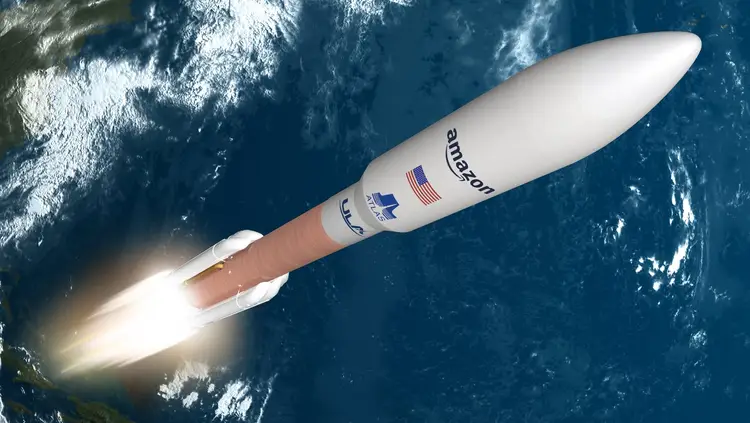Amazon to Compete with NBN by Launching 450 Mbps Satellite Service.

Amazon aims to offer high-speed internet with a speed of 450mps through satellites directly in Australia. This could potentially have a negative impact on NBN and carrier services, and potentially reduce the need for 5G towers.
Similar to SpaceX's Starlink, Amazon's Project Kuiper will rely on a group of compact satellites to deliver a global internet service. Customers will merely require a petite Amazon terminal measuring approximately 28 centimeters across.
A smaller Amazon terminal is available that can provide a speed of 100mps for delivery.
In order to utilize the service, patron will need to set up an external device, commonly known as a customer terminal, that will connect with orbiting satellites.
Historically, numerous customers found it challenging to close the digital gap through LEO constellations, primarily due to the large, intricate, and expensive equipment. However, Amazon's engineers came up with solutions to address these issues.
Amazon has stated that Project Kuiper has high aspirations to provide its services to millions of clients. Therefore, to achieve this, they have set a challenging objective of creating a customer terminal that can be produced for less than $500.
The engineers working on Project Kuiper achieved a significant accomplishment last year by creating a new antenna structure that was lighter and more compact compared to conventional designs.
Ever since, the Amazon crew has been coming up with new and creative ways to shrink the size of their terminals, lower their cost, and improve their overall functionality compared to their earlier models.
The Amazon-designed baseband chip named "Prometheus" will be used to power the terminals of the Project Kuiper.
According to the company, Prometheus is made up of a mixture of technology including a 5G modem chip that can be found in current mobile phones, a system like a cell phone tower that can manage communication from multiple users simultaneously, and a microwave backhaul antenna capable of creating strong connections between two points.
Families are allowed to link their streaming gadgets, personal computers, and mobile phones into the Amazon net.
It is estimated that The Terminals will be sold for approximately $549.
The main inquiry is if Amazon plans to offer the service directly or through a carrier like JB Hi-Fi.
Amazon has unveiled the equipment that initial users of its Project Kuiper space-based internet service will utilize.
Similar to how Starlink by SpaceX works, Project Kuiper aims to offer high-speed internet to customers worldwide by utilizing a group of compact satellites. However, the project will primarily focus on servicing communities that do not have access or have limited access to the internet, which is something current technologies fail to provide.
Amazon is promoting this tinier plan to "patrons in search of a more budget-friendly option, along with corporations and government firms who are exploring uses such as terrestrial transportation and internet-connected devices (IoT)."
Amazon has devised a cutting-edge infrastructure catered towards prime corporate clients with rigorous requirements. This high-bandwidth arrangement is ideal for extensive operations undertaken by large-scale customers, specifically those involved in government, business or telecommunication sectors.
These plates have dimensions of 19 inches by 30 inches and can reach a maximum speed of 1 gigabit per second (Gbps).
Amazon has designed a baseband chip with the code name "Prometheus" to power Project Kuiper terminals.
According to the company, Prometheus integrates various technologies to boost its abilities. It merges the superior processing strength of modern smartphone's 5G modem chip, the potential of a cellular base station to manage tons of client traffic simultaneously, and the potential of a microwave backhaul antenna to foster sturdy point-to-point communications.
Amazon plans to accelerate the implementation of Project Kuiper by launching its initial two demo satellites on the first-ever mission of the Vulcan Centaur rocket operated by United Launch Alliance in May.
Assuming the satellites operate according to plan, large numbers of them will be launched beginning in early 2024, following a similar pattern to SpaceX's Starlink deployment. This will allow Project Kuiper to commence service to its initial customers towards the end of that year.
The NBN reduced its workforce by 500 individuals this week, as it confronts fresh rivalry from companies such as Amazon.
For over three decades, David Richards has been passionately writing about technology. Before his career in tech journalism, he worked as a journalist for Fleet Street. One of his most notable works is the Federated Ships Painters + Dockers Union series for the Bulletin, which eventually led to a Royal Commission. He also won the Logie Award for Outstanding Contribution To TV Journalism for his work in The Werribee Affair. Richards is the founder of the largest tech media company in Australia, established in 1997, and previously led the third largest PR company that is now known as Ogilvy PR. Today, he still writes about technology and its impact on both businesses and consumers.









































